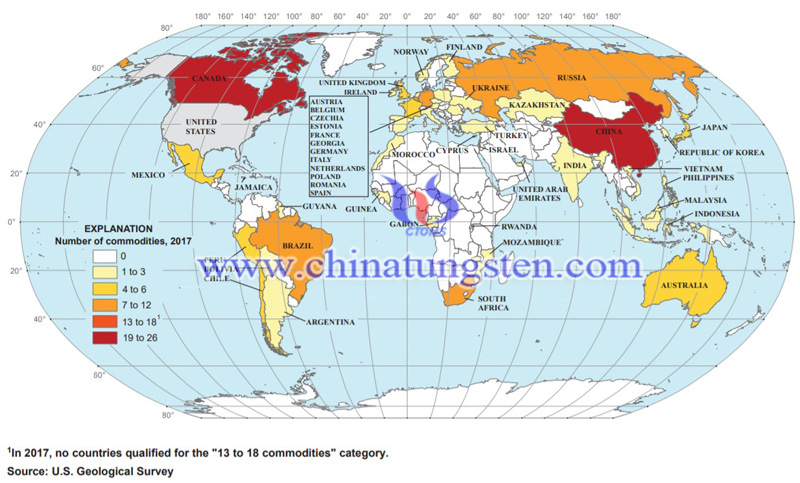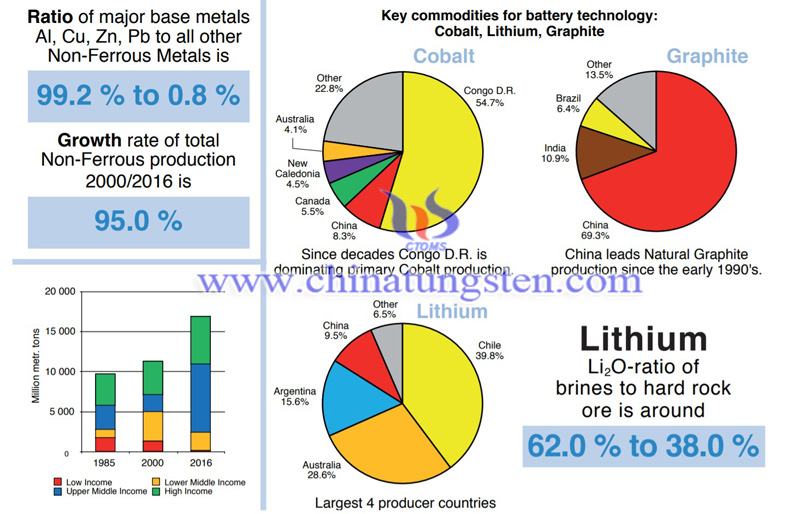Tungsten, Cobalt, Lithium and Rare Earth's Reserves in Nine US Strategic Minerals Initiative Countries
- Details
- Category: Tungsten's News
- Published on Tuesday, 08 October 2019 12:05
To help discover and develop reserves of minerals such as tungsten, cobalt, lithium, copper and rare earth that used to make electric vehicles, part of an effort to cut the world’s reliance on China for the high-tech materials. The United States said nine countries have joined the US Strategic Minerals Initiative The countries include Australia, Botswana, Peru, Argentina, Brazil, the Democratic Republic of the Congo, Namibia, the Philippines, and Zambia. The resource reserves in each country are respectively as follows:

Australia, the country that sits on the mine car. According to USGS data, Australian lithium resources are 2.7 million tons, around 19% of global supply, 2018 lithium mine output is 51,000 tons, accounting for 60% of the global output. Tungsten resources are about 10,000 tons, about 0.3% of the world total. 2018 tungsten ore production is 980 tons, contributing 1.2% of the world's output. Rare earth resources are 3.4 million tons, accounting for 2.8% of the world total. The amount of cobalt resources is 1.2 million tons, around 17.4% of the world total. In 2018, the output of cobalt is 4,700 tons, accounting for about 3.4% of the world total.
Botswana is rich in mineral resources. The main mineral deposits include diamond, copper, nickel, coal, soda ash, platinum, gold, and manganese. According to the data of the Embassy of the Republic of Botswana, Botswana has proven copper and nickel deposits of 46 million tons.
Peru, one of the world's 12 largest mineral countries, possesses 2,400 tons of molybdenum resources, accounting for 41% of the world total. In 2018, molybdenum mines produced 28,000 tons, accounting for 9.3% of the world's output. Copper resources amounted to 83,000 tons, 10% of the world total. In 2018, the output of copper mines was 2,400 tons, about 11.4% of the world's output. Last year, 2.5 million tons of high-grade large-scale lithium deposits were discovered in southern Peru, which may be the world's lithium largest mine.
Argentina owns major mineral resources such as copper, gold, uranium. According to USGS data, Argentina has 2 million tons of lithium resources, which is 14% of the world's total. In 2018, lithium mines produced 6,200 tons, accounting for 7.3% of the global production. Molybdenum resources are 100 tons, accounting for about 0.59% of the world’s total, the annual production of molybdenum ore is 450 tons, accounting for about 0.15% of the world's output.
In Brazil, 29 kinds of mineral reserves such as niobium, manganese, titanium, bauxite, lead, tin, iron and uranium are among the highest in the world. According to the USGS data, Brazil's lithium resources amounted to 54,000 tons, about 0.38% globally. In 2018, lithium mines produced 600 tons, accounting for 0.7% of the world's output. Rare earth resources amounted to 22 million tons, accounting for about 18.3% of the world total. In 2018, the output of rare earth is 1,000 tons, accounting for about 0.59% of the world's output.
The Democratic Republic of the Congo, the world's raw material warehouse. According to USGS data, Congo's cobalt resources amount to 3.4 million tons, accounting for about 49% of the world total. In 2018, cobalt mines produced 90,000 tons, accounting for about 64% of the world's production. Copper resources amounted to 20,000 tons, accounting for about 2.4% of the world total, copper mine output is 1,200 tons, accounting for about 5.7% of the world's total output.
Namibia is rich in minerals such as diamonds, uranium, copper, and silver. According to USGS data, in 2018, the output of lithium mines in Namibia was 500 tons, accounting for 0.59% of world production.
In the Philippines, according to USGS data, the cobalt resource is 280,000 tons, accounting for 4% of the world total. In 2018, the cobalt mine output is 4,600 tons, contributing to 3.3% of the world total.
Zambia, the country of copper mines. According to USGS data, Zambia's copper resources are 19,000 tons, accounting for about 2.3% of the world's total. In 2018, copper mines produced 870 tons, accounting for about 4% of the world's total output.

Under the Energy Resource Governance Initiative announced in June, the US will share mining expertise with US Strategic Minerals Initiative member countries to help them discover and develop their minerals such as tungsten, cobalt, lithium, and rare earth, as well as advise on management and governance frameworks to help ensure their industries are attractive to international investors.
- Tungsten Manufacturer & Supplier, Chinatungsten Online: www.chinatungsten.com
- Tungsten News & Prices of China Tungsten Industry Association: www.ctia.com.cn
- Molybdenum News & Price: news.molybdenum.com.cn
- Tel.: 86 592 5129696; Fax: 86 592 5129797; Email: sales@chinatungsten.com



 sales@chinatungsten.com
sales@chinatungsten.com